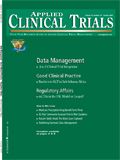Not Yet the Last Word on First-in-Man
Europe's clinical trial community has a lot to say about the EMEA's draft guidance on first studies in man.
The shadow of TGN 1412 still hangs over Europe. The serious side effects experienced by volunteers in March 2006 during the first-in-man clinical trial of this monoclonal antibody continue to trouble the whole of the clinical trial community in Europe. In consequence, action is underway from industry, investigators, and authorities to avoid the risk of such dramatic events recurring in a first-in-man trial.

Peter O'Donnell
As this column commented on earlier this year (View from Brussels, May 2007), the European Medicines Agency is drafting guidance on the subject—and following the draft document it published in March [http://www.emea.europa.eu/pdfs/human/swp/2836707en.pdf], it held a major consultation meeting during the summer to assess how to proceed.
The initial draft guidance has been the subject of wide comment in the clinical trials community and beyond, and the Agency now has the delicate task of producing a final document that picks its way adroitly among the many opinions expressed—not all of them consistent.
The concept of standardized guidance has met with general acceptance. "The draft appears to be very useful to elevate the safety of first-in-man trials," as the UK's Association for Clinical Pharmacology and Therapeutics put it. The European Clinical Research Infrastructures Network describes it as "a brilliant overview of a very complex issue."
There are some common themes in the comments, and one above all stands out: The question of definitions.
Difficult definitions
The draft guideline refers to "high-risk" medicinal products, raising the tricky question of just what that means. As numerous comments to the Agency point out, the definition will have to follow clear and narrow guidelines because once a product is considered to be a high risk, a large battery of additional studies and approval processes will be launched.
The UK BioIndustry Association warns: "If the criteria are not defined precisely, there is a potential for misapplication. If the definition of high-risk products is applied too widely, this could have a detrimental effect on innovation [and] will create an excessively burdensome regulatory environment that will be damaging to the development of innovative medicines."
Centocor Research & Development suggests getting around this problem by refocusing the guidance on risk management, risk mitigation strategies, and dose setting for all first-in-human clinical trials. "This would remove the need for a definition of 'high risk,' whilst still addressing appropriate risk management strategies," it says.
The problem of definitions is spelled out at length by the Department of Clinical Pharmacology and Centre for Human Drug Research at Leiden University's Medical Centre, which cautions that "the guideline in its current form may do a disservice to rational and safe drug development" by its attempt "to dichotomize high-risk and nonhigh-risk compounds, which is impossible." It questions the distinction the draft guidance draws between "potential high risk" and "non-high risk" compounds, and rejects the guideline's suggestion that there are low risk compounds. "In fact, most new drugs explore novel mechanisms of action, and animal models are rarely fully predictive of the effects of the compounds in man. Therefore, classifying drugs as low risk may increase the risk for participants in trials, because it may result in performance of trials with less stringent rules than warranted."
The European Federation of Pharmaceutical Industries and Associations finds that the major problem with the draft guideline is "the differentiation of 'high-risk' investigational medicinal products from the rest. Assigning a compound to one category versus the other could be viewed as being arbitrary. Risk is related to the doses administered in the clinical trials—not the product itself—and to the clinical trial design.
Delaying drug development
The bottom line of many comments—particularly from industry—is that drug development may be delayed by excessive regulation, so there are repeated calls for a balance between ensuring the safety of trial subjects and making the European Union an attractive place for cutting-edge biomedical research.
The verdict of the European Association for Bioindustries is harsh: In its current form, the guideline "will delay first-in-man clinical trial initiation." It is particularly concerned that the specific characteristics of vaccines, blood-derived products, and other immunotherapies are not catered for in the guidance.
The view is echoed by Fresenius Biotech, speaking for the European Biopharmaceutical Enterprises: "A balance between the need to safeguard clinical trial subjects on the one hand and the need for continued development of innovative medicines on the other hand is important. An environment promoting clinical development is key to ensure public health by generating new treatments with the potential to address unmet medical needs...Compliance with this guideline could greatly increase both time and resources necessary to filing clinical trial applications and generate significant data that is potentially difficult to interpret and is of questionable value."
For the European Federation of Pharmaceutical Industries and Associations too, "Many points require clarification to avoid risk of misinterpretation, lack of flexibility, and a more conservative interpretation; this could imply unnecessary hurdles for drug development without leading to gains in safety."
Unduly diffuse
The other most common concern is that the proposed guidelines are not strict enough or sufficiently prioritized, and would not, as they stand, have prevented the TGN 1412 trial from going ahead as it did. According to Bristol-Myers Squibb, the draft's "inherent uncertainty leaves a degree of vagueness which, without further refinement or additional opportunities for timely and more specific guidance, may not provide the intended assistance to sponsors in transitioning from nonclinical to early clinical development, particularly regarding their planning of how, when, and where to conduct the First-in-Human study." Similarly, for the BioIndustry Association, "certain sections provide too general guidance that may be of little use to applicants" and "there is a lack of illustrative examples to provide practical guidance to all applicants in dealing with issues relating to transition from nonclinical to early clinical development."
The Federation of European Cancer Societies finds the document "very general in its language," and urges improvements "by adding specific examples or indicating specific areas where, for example, patients would be more appropriate than healthy volunteers." Merck Sharp & Dohme (MSD) Europe shares the view that the document is "too general, open to interpretation, and does not provide specific guidance." In particular, "There are not clear definitions of the criteria for what a high-risk molecule is and importantly what a high-risk molecule is not. Specifically, the differences in requirements or considerations for a high risk vs. standard molecule are unclear." Instead, MSD suggests producing guidance that defines the limited circumstances for which concerns exist over the mechanism of action of the molecule or the relevance of preclinical evaluations to predict human toxicity.
The same hunger for concrete guidance is evinced by the German Association for Applied Human Pharmacology: "We understand that an exact definition of different risk categories is not easy because such a classification depends on many individual factors. However, we propose that the guideline should be more specific and more obliging in terms of giving recommendations and instructions to sponsors and investigators."
Meanwhile, Paul Jones, commenting on behalf of Cancer Research UK, remarks that the draft guidance focuses on healthy volunteer clinical trials. "There is no mention of how the guidance fits in with existing guidances on patient clinical trials and in particular cancer and HIV patient clinical trials. The guidance concentrates on the assessment of risk alone rather than the assessment of risk-benefit necessary in patient clinical trials."
Radical review
And there are views that go beyond the specific issues of first-in-man trials in high-risk products. Stephen Senn at the University of Glasgow, commenting on behalf of the Royal Statistical Society, makes the point that the draft neglects the question of informed consent, and says nothing about the risk information the sponsor should share with subjects in the trial or about statistical analysis. "If the results from such a trial are to be used, they will need to be analyzed and different designs will be suitable for different intended analyses and vice versa," he argues.
Not considering the intended analysis would be unthinkable in the case of a Phase III trial, says Senn: "The fact that this has not been mentioned here is indicative of a mentality that this guideline will do nothing to dispel the unfortunate belief that Phase I studies are not really serious experiments. And that from the scientific point of view, no care needs to be taken in their design because in general they will not receive public scrutiny."
The question of consent is also high on the agenda of the Standing Committee of European Doctors, which suggests that ethical issues receive more attention in the guidance. It proposes "a well-prepared information sheet for research subjects, emphasizing the background to existing animal studies, and the particular precautions that will be taken in the first human trials; a specific commentary that the product being tested is a high-risk compound, with a higher level of uncertainty than is usual; a more detailed explanation than is usual about the mode of action of the product and steps to be taken in the event of unexpected adverse reactions; and a sufficient period of time to be provided for a decision by participants whether to take part, and the opportunity for [subjects'] concerns to be shared with experts not associated with the trial itself."
A similar emphasis on the ethical dimension comes from the European Forum for Good Clinical Practice: "This guideline concentrates very much on the scientific and technical aspects of first-in-man trials but does not sufficiently consider ethical aspects like information to subjects, indemnity coverage requirements, and medical safeguards during and after the study performance," it comments. Notably, when discussing clinical requirements, "more guidance should be given in terms of qualifications/certification of investigators and site personnel...A Phase I unit should be able to anticipate each type of life-threatening event...We are very much concerned that the required level of experience and qualification of investigators responsible for first-in-man trials are not specified in the guideline."
Responding to pressures
It is also worth noting a contribution from The Good Clinical Practice Alliance–Europe, which underlines the impact of the increasingly tough commercial context for clinical trials. "Due to financial, market, and patient pressures, there is an increasing emphasis by sponsors on accelerating the development of molecules from bench to market," it says, adding that "the ongoing European attempts to streamline legislation and procedures testify to these pressures, often felt particularly acutely in the decision-making processes concerning the move to first-in-man studies."
Globally, the pressure on such decision-making and risk analysis is also growing, argues the Alliance, and it also shows itself in the increasing globalization of Phase I clinical trials. "The European Union needs to strengthen its competitive edge in this highly pressurized and global market of first-in-man studies. The best way to do this is by providing public assurances of the sound scientific and ethical basis for the first-in-man studies approved and carried out within the EU," it says. "This proposed guideline should assist Europe in moving closer to the needed public assurances."
Its comment is accurate—except that the nature of the proposed guideline remains unknown. The EMEA has a lot riding on how it cuts through this Gordian knot over the coming weeks.
Peter O'Donnell is a freelance journalist who specializes in European health affairs and is based in Brussels, Belgium.
FDA Fast Tracks Johnson & Johnson’s Nipocalimab for Fetal Neonatal Alloimmune Thrombocytopenia
March 27th 2024Johnson & Johnson is moving forward with a pair of Phase III trials of nipocalimab to reduce the risk of fetal neonatal alloimmune thrombocytopenia in alloimmunized pregnant patients.
